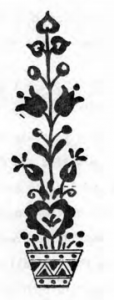Part IV: The Slovak Community of Cleveland
Customs and Holidays
Weddings
The sacrament of marriage itself remained as festive an occasion as in the Old World and underwent few changes in America. Since this celebration involved not just the immediate family but the whole community, elaborate preparations had to be made. Several months before the event the father of the bride rented the church basement and began to stock it with liquor. The mother, with the help of many of her friends and relatives, began to cook and bake choice specialties weeks in advance.
On the appointed Saturday the chosen couple was united in matrimony at a joyous High Mass which included the liberal use of rosemary sprigs (for fertility — an old pagan custom). After the religious formalities ended, a “starosta” (master of ceremonies) led the newlyweds in a procession to the church basement where several hundred guests gathered to eat a dozen courses of food and drink to the health of the couple. While the meal was being devoured, the “starosta” provided comic relief by giving the newlyweds some “serious” advice.
Folk music, played by Gypsies if possible, lured people to the dance floor where the celebration continued into the wee hours of the morning. Sometimes a good, fight erupted, necessitating the calling of Irish policemen and these, after restoring order, often joined the festivities. The merrymaking lasted through Sunday and often Monday, making weddings a perpetual headache for foremen of factories.
In only two small ways did American Slovak weddings differ from those of the Old World — the choice of days and the lack of a dowry. In Slovakia the celebration usually began on Monday and lasted through Wednesday but American work schedules prevented this. Dowries were found to be impractical in America and money took their place. Hence, the bride offered to dance with any man willing to pay her a small token (25 cents to a dollar) and raised a respectable sum for the future. Many guests donated money outright to the newlyweds. Through such a happy celebration of a major step in life, young newlyweds found themselves firmly established in the growing American-Slovak community.
A Slovak Christmas
Christmas is special for many peoples, and so were my “Slovak” Christmases as a child. On the vigil of Christmas which we called “Velija” we watched our mom prepare “bobalki” which were made from bread dough, but these little parker-house rolls, the size of marshmallows, were popped into boiling water instead of the oven. Once drained they were smothered either with buttered sauerkraut (which the adults usually favored) or with cooked poppy seed mixed lavishly with sugar and butter, and naturally, were usually suited to the taste of the children. Depending on which “vallal” (county) one’s parents came from, other dishes were prepared and differed greatly according to the district. My parents were from Zemplin and I would imagine that others from there must have prepared this next dish which, because it was sour, was not my favorite. It was called “juška” (literally juice) and was made from sauerkraut juice to which “źapražka” (thickening) was added. To this soup, were added broad homemade noodles.
On special occasions such as this, we ate in the dining room. I think mom was the one who said grace, but what she did next was indeed more memorable for me. Into the glass container which held honey, she dipped her little finger and made the sign of the cross on each of our foreheads. She then gave us each a clove of garlic and told us to dip it into the honey and eat it. After many contortions my two sisters and I managed this feat, and the taste of garlic and honey can still be recalled. For some reason, we never seemed to question the reason for this ritual, but now, looking back, there seems to be a logical, if symbolical explanation. Since garlic is bitter and honey is sweet, garlic is the symbol of life on earth — much of it can be bitter, but life can be sweetened with a little bit of honey! And the sign of the cross on our foreheads was likely the Slovak’s way of asking God to sweeten the crosses which, as a Christian, he knows he has to bear.
For dessert mom baked delicious nut and poppy seed rolls and “ročliky” (butter cookies with filling). There were also nuts and candy on the table but this was probably a typical American addition. After we ate, mom and dad would sing the carols either in Slovak or Slavonic (we are Byzantine Slovaks) and we would try to join in when we could. Soon it would be time for Midnight Mass, and because it was so unusual to have Mass in the evening (Mass was never said in the afternoon or evenings then) we all went, and joy of joys, mom let us go up into the choir loft on this special occasion where, after watching the people below us from this incredibly great height, I inevitably fell asleep during the sermon.
During the Christmas season men from our church would dress up as shepherds or angels and visit homes singing carols and wishing everyone well. While most people called them “jasličkari” we kids called them kubi-zoobies. Why we called them that I don’t know, but I do remember hiding from them during one Christmas season. They came to our house in the evening, and for me, they were frightening because in their efforts to resemble shepherds they stuffed their trousers so that their legs looked like fat sausages. From my hiding place, under my bed, I could hear them wish the family, “Vesele Vianoce” (Merry Christmas).

